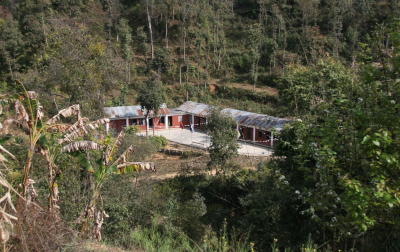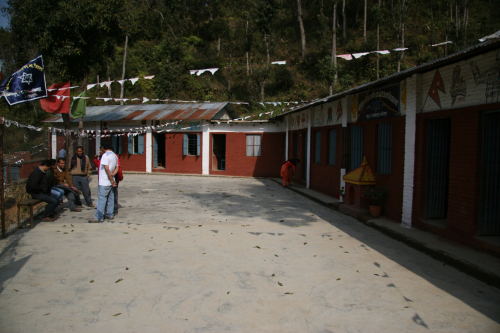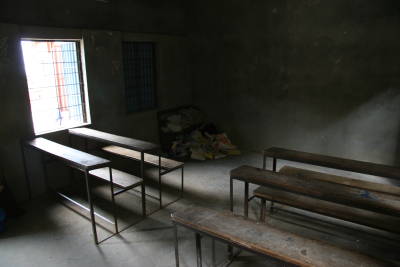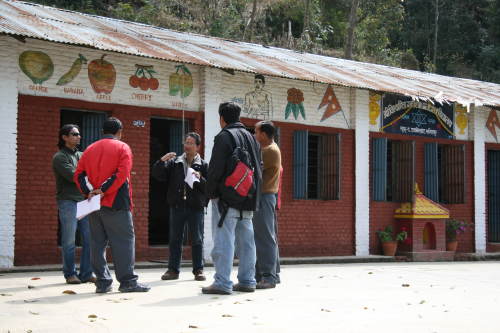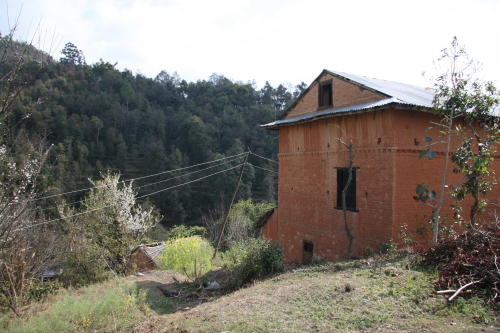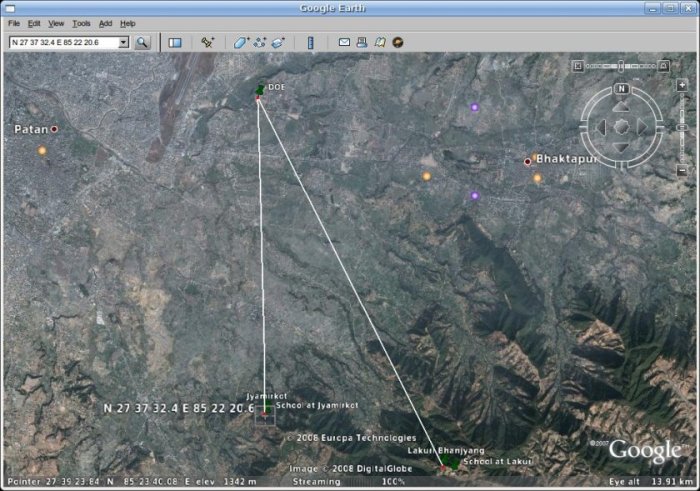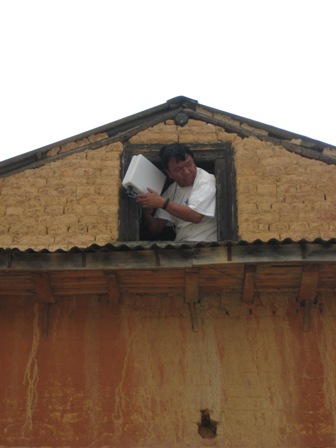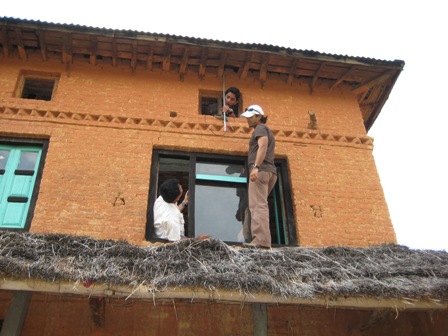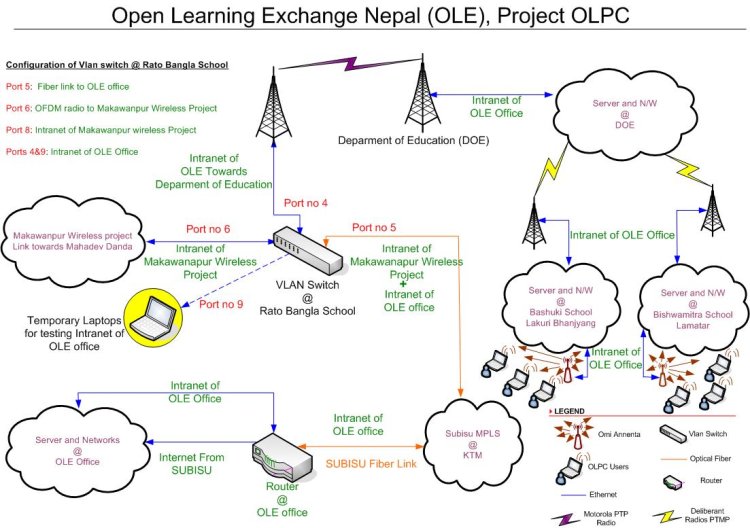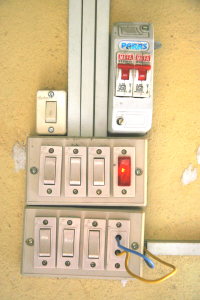Bishwamitra Journal
Translate this page with Google -español -български -中文(中国大陆) -中文(臺灣) -hrvatski -čeština -dansk -Nederlands -suomi -français -Deutsch -Ελληνικά -हिन्दी -italiano -日本語 -한국어 -norsk -polski -português -română -русский -svenska
Ulaanbaatar.mn | Arahuay.pe | Khairat.in | Ban Samkha.th | Galadima.ng | Cardal and CEIBAL.uy | Bashuki.np | Bishwamitra.np | Atlas School.pk | Altos de Cazucá.co [+/-]
Bishwamitra Lower Secondary School
I will note down the details of this pilot school as they happen. Bryan Berry 08:42, 7 March 2008 (EST).
For the most up-to-date details, see the OLE Nepal blog
See also Bashuki_Journal for information on Nepal's other pilot school.
For comprehensive information about the Nepal's deployments, including planning, technical, and pedagogical preparations, see the Implementation section of the OLPC Nepal wiki page
Background
The pilot will begin on the first day of the Nepali school year, April 14th.
Community
Bishwamitra School is located in the village of Jamirkot, roughly 8 km east of Kathmandu. www.babapandey.com
The School
The school is roughly 30 minutes walk from the main road. This school is more accessible than Bashuki School. It is a poor school with a mix of Dalit (untouchable), Chettry, and Brahmin children. It is physically much smaller than Bashuki school and has a smaller student population.
Below is a closer view of the school. It is physically very small and serves roughly 240 kids, classes 1-8.
The classrooms for Class 2 and 6 are the same size. Below is the room for Class 6. It measures 5.15 m x 4.21 m. The desks are 1.57 m in length and 25 cm deep. Here again it will be very easy for the laptops to fall forward off the desks. We will need to rearrange the benches so that the children are facing each other and looking sidelong at the teacher. Children will have less elbow room to type due to the small size of the benches.
Planning
Discussing the implementation with the teachers. Dr. Saurav Dev Bhatta of OLE Nepal is in the center. Dr. Dev Bhatta is Education Director for OLE Nepal. To the left wearing sunglasses is Rabi Karmacharya, Executive Director of OLE Nepal. I (Bryan Berry) am the Director of External Relations which means I write blog posts and wiki pages detailing their work :).
Network
[Techical Details and Update by Dev Mohanty]
Mahabir Pun is in charge of all network and infrastructure planning and Dev Mohanty is the network engineer.
We plan to use a 12 dbi omni-directional antenna from Deliberant Networks, onsite at the school. We will likely not use the Active Antenna, at least initially. We are using a Deliberant DLB-2701 as the access point. It costs roughly 250 usd and a 12 dbi omni radio which has a range of 12 km in ideal conditions. It operates in the 802.11 b/g wifi range.
We are using Deliberant brand of radio for the point-to-point connection to the Department of Education, which is about 8 km away by road. The radio has an effective bandwidth 8 Mbps. Since the radio will be transmitting at a distance of 3 km to the Department of Education located in the Kathmandu Valley, interference will be an issue.
The school itself is a bad location for our long range antenna as it is nestled into the hillside. It does not have line-of-sight with the Department of Education. Instead we are using a house located on the hill opposite the school as a Relay site.
The owner of this house has generously agreed to let us mount our network equipment on his house. We will place the Point-to-Point antenna in the topmost window, which has a line-of-sight view with our Multi-point radio at the Department of Education. We will place our omni-directional antenna on the lower part of the roof facing towards the school. This house is roughly 100 meters from the school. We will have to test the signal strength within the classrooms. If it is too weak, we will run a Cat 6 cable down to the school. We also like putting the antenna in the house because the antenna will less likely be stolen.
We do not intend to use VSAT for any of Nepal's pilot schools. Installation is not terribly expensive but monthly bandwidth charges are prohibitively expensive when compared with the cost of long-range wifi networks, as pioneered by Nepal Wireless
[15th March 08 Update]
We got a 16dbi Deliberant installed at DOE. Being a hazy day, the hills where the schools are located were pretty much next to not being visible. So getting the angles right was all the more challenging, as this relay needs to be broadcasting to both schools simultaneously. And unlike a Canopy a Deliberant radio can broadcast to different relays within an angle of 60-70 degrees.
[16th March 08 Update]
We headed off to Bishwamitra School, this time we were accompanied by Mahabir Pun, Rabi & Sulochan. Mahabir had been approached by a TV company, who needed some shots of him working on site for an ad campaign. So we decided to to club in and take the crew to Jyamirkot as we needed to install a couple of radios there for the school.
It was an hours ride to the base of the hill and a 15 mins trek up with all the equipment. We were welcomed by the school authorities, who got busy right away arranging for electricity for the house where we'd decided to get the radios installed. Believe this house had not been inhabited in quite a while and was completely empty.
We had a jolly good time unpacking and getting the radios fixed up while the film crew was busy shooting us at it and with our brilliant acting skills, the crew needed no retakes! Once they had their shots we got to some serious work.
The 16dbi radio got fixed at the window looking out to the valley below, where DOE is located. Once installed we were able to connect to the other radio at DOE which had just been fixed the previous day. Though it needed a lot of tweaking to improve the signal and at best we got connectivity at 84 dbm rssi with 10% packet loss. So we decided that the radio at DOE needed a bit more tweaking or we might have to be change it to a 19dbi Deliberant radio. As Kathmandu International Airport happens to be right next to DOE, we're assuming it might be causing a lot of interference and hence the packet loss.
Rabi and Sulo got the Omni antenna fixed by the side of house facing the school. This 12dbi antenna is attached to a DLB2701 access point, which is a 250 mw radio. Sulo had taken a XO with him to test the AP range and was satisfied with the signal around the school and the village. If required we would also enhance the signal by adding a reflector to the omni facing the school to make it work as a sectoral antenna.
With the omni working out to our expectations, we're glad that we didn't have to use the CAT6 cables that we had taken along with us. As it would have been a herculean task having to connect it all the way to the school from the relay.
[19th March 08 Update]
We installed an 19dbi Deliberant at DOE and removed the 16dbi radio. We're now connected to the school at 70 dbm Rssi and 0% packet loss, which is just what we needed.
[22nd March 08 Update]
Connectivity diagram for Open learning Exchange to DOE and the pilot schools.
Power
Ram Krishna Singh is the lead power technician for the pilot.
Stable electricity is a significant problem everywhere in Nepal. Currently the school only receives 16 hours of electricity per day. This should decrease to 15 or 14 hours per day by April. Hydropower generates most of the electricity for Nepal's energy grid and the amount generated decreases steadily during the dry season, October - May.
The school borrows power from a neighboring house and does not have its own power line. The school administators are arranging to get their own power line rated at 15 amps at our request.
Power is also of low quality, with frequent brownouts and power spikes. The power strips available in Nepal are of very low quality, there is high chance that children will shock themselves while removing their plug from the power strips. It is not uncommon to see a spark when you insert a plug into the particular power strip available in Nepal.
We will install a “charging rack” at the back of each classroom. The children will unplug the XO’s and use them at their desks untethered by power cables. There will be a space and charger for each child’s XO in the rack. We do not plan to run power cables to the desks. The chance that kids will trip over power cables is just too high.
We would love to use the Xoctoplug for power distribution should it become available. It is much more elegant and safe manner of distributing power than regular power strips. We would place the Xoctoplug in the middle of 4 desks and the kids would plug into the Xoctoplug. Since the Xoctoplug distributes DC current it is much more efficient and safer than an AC power strip. Additionally we could daisy-chain two Xoctoplugs together so that we would only have live power cable per 8 kids, as opposed to one live power cable for every 3 kids which we would need for power strips.
We will install power inverters in the school to maintain power during power outages. We will keep the inverters in the same location as the School Server.
The school currently is connected to mains [grid line] without any meter in between school and main line. The circuit breaker shown in the picture has been chosen by school arbitrarily and its rating is 5amp at 220v for the protection purpose.
As we are preparing ourselves for the pilot phase at the school, OLE wants the electrification module to be updated and make it meet the Nepali government standard and long with future requirements in mind.
We are planning to get supply at 230v with 15 amp rating so that even when the load at the school increases (for various reasons) we don't have any setback from the power sector side not only now but in the future as well.
Power requirement in school:
- Electric bulbs ~ 25-30 , Two bulbs in each class room plus additional lights in staff room, toilets and school surroundings.
- Desktop computers -2 (this number can increase)
- Server 1
- Running 40+ oplc laptops
- During winter season, staff room might have heaters
- During school function days, the power requirement might spike up pretty high.
Naturally, as the school develops and expands, power consumption also increases. Keeping these entire things in mind, we would like to prepare ourselves and leave nothing for chances.
School Server
We keep the School Server in the prinicipal's office. It and the wifi routers have their own UPS.
Physical Security
Bishwamitra school is more physically secure than Bashuki school. There is a tall chain-link fence topped with barbed wire surrounding the school. There are locks on all the classrooms.
We expect the children to take their XO's home with them but the School Server, power backup equipment, and charging racks will need to be secured. Power backup equipment is particularly valuable in Nepal due to supply shortages.
Experiences
For full details see the following:
